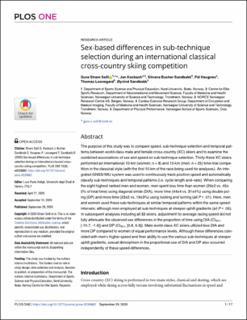| dc.contributor.author | Solli, Guro Strøm | |
| dc.contributor.author | Kocbach, Jan | |
| dc.contributor.author | Bucher Sandbakk, Silvana | |
| dc.contributor.author | Haugnes, Pål | |
| dc.contributor.author | Losnegard, Thomas | |
| dc.contributor.author | Sandbakk, Øyvind | |
| dc.date.accessioned | 2021-02-23T14:32:50Z | |
| dc.date.available | 2021-02-23T14:32:50Z | |
| dc.date.created | 2020-10-26T18:32:31Z | |
| dc.date.issued | 2020 | |
| dc.identifier.citation | Solli, G. S., Kocbach, J., Sandbakk, S. B., Haugnes, P., Losnegard, T. & Sandbakk, Ø. (2020). Sex-based differences in sub-technique selection during an international classical cross-country skiing competition. PLoS ONE, 15(9): e0239862. doi: | en_US |
| dc.identifier.issn | 1932-6203 | |
| dc.identifier.uri | https://hdl.handle.net/11250/2729919 | |
| dc.description.abstract | The purpose of this study was to compare speed, sub-technique selection and temporal patterns between world-class male and female cross-country (XC) skiers and to examine the combined associations of sex and speed on sub-technique selection. Thirty-three XC skiers performed an international 10-km (women; n = 8) and 15-km (men; n = 25) time-trial competition in the classical style (with the first 10 km of the race being used for analyses). An integrated GNSS/IMU system was used to continuously track position speed and automatically classify sub-techniques and temporal patterns (i.e. cycle length and–rate). When comparing the eight highest ranked men and women, men spent less time than women (29±2 vs. 45±5% of total time) using diagonal stride (DIA), more time (44±4 vs. 31±4%) using double poling (DP) and more time (23±2 vs. 19±3%) using tucking and turning (all P < .01). Here, men and women used these sub-techniques at similar temporal patterns within the same speed-intervals; although men employed all sub-techniques at steeper uphill gradients (all P < .05). In subsequent analyses including all 33 skiers, adjustment for average racing speed did not fully attenuate the observed sex differences in the proportion of time using DIA (CI95% [-10.7, -1.6]) and DP (CI95% [0.8, 9.3]). Male world-class XC skiers utilized less DIA and more DP compared to women of equal performance levels. Although these differences coincided with men’s higher speed and their ability to use the various sub-techniques at steeper uphill gradients, sexual dimorphism in the proportional use of DIA and DP also occurred independently of these speed-differences. | en_US |
| dc.description.abstract | Sex-based differences in sub-technique selection during an international classical cross-country skiing competition | en_US |
| dc.language.iso | eng | en_US |
| dc.publisher | PLOS | en_US |
| dc.relation.uri | https://journals.plos.org/plosone/article?id=10.1371/journal.pone.0239862 | |
| dc.rights | Navngivelse 4.0 Internasjonal | * |
| dc.rights.uri | http://creativecommons.org/licenses/by/4.0/deed.no | * |
| dc.title | Sex-based differences in sub-technique selection during an international classical cross-country skiing competition | en_US |
| dc.type | Peer reviewed | en_US |
| dc.type | Journal article | en_US |
| dc.description.version | publishedVersion | en_US |
| dc.rights.holder | © 2020 The Author(s) | en_US |
| dc.subject.nsi | VDP::Medisinske Fag: 700::Idrettsmedisinske fag: 850 | en_US |
| dc.subject.nsi | VDP::Matematikk og Naturvitenskap: 400 | en_US |
| dc.source.pagenumber | 17 | en_US |
| dc.source.volume | 15 | en_US |
| dc.source.journal | PLOS ONE | en_US |
| dc.source.issue | 9 | en_US |
| dc.identifier.doi | 10.1371/journal.pone.0239862 | |
| dc.identifier.cristin | 1842434 | |
| dc.source.articlenumber | e0239862 | en_US |

